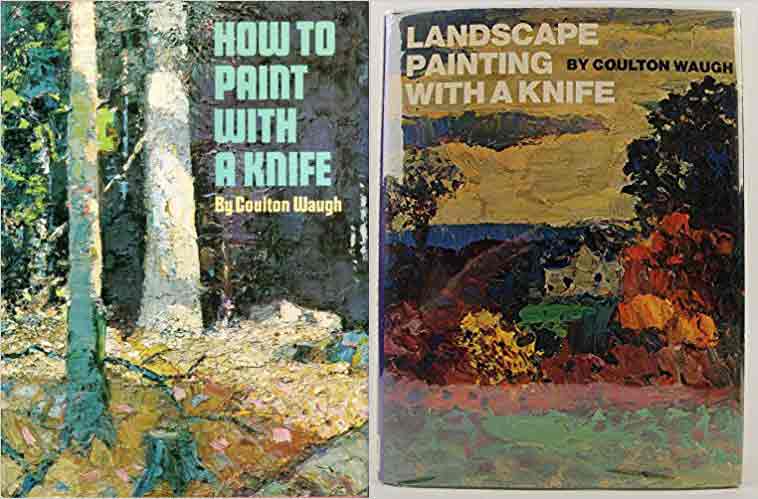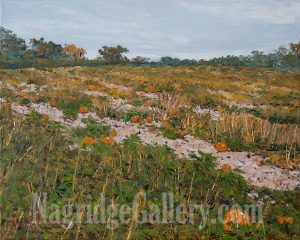So what kind of paint do you want to use when you go out to paint plain air — acrylic or oil? Let’s do some comparing.
Acrylic paints
Acrylic paints are basically polymer with pigment. They’ve definitely got some nice advantages over oil paints:
- They dry quickly. When you’re done with your plein air acrylic, the painting will probably be dry by the time to take your set-up down. No worries about getting paint accidently all over your car or clothes throughout the day and beyond.
- Because of their fast drying time, it’s easy to cover up mistakes or to put an opaque layer on top of paint underneath.
- You don’t need solvents. If you work with brushes, you just need water to rinse them, and water and soap to clean them afterward.
- Acrylic paints generally cost less than oil paints.
So what are the disadvantages?
- Acrylic paints tend to dry darker than when you apply them. Not only does this alter the look of your painting, but it can make it very difficult to mix and match a certain color on the painting after it’s dried on your painting.
- Because of their fast drying time, it’s very difficult to get beautiful wet-on-wet effects. Once the paint on your painting is dry, you can’t work fresh paint into it for painterly blending effects.
Oil paints
I’m going to start with the disadvantages first.
- They can’t clean with just water. If you use brushes, you have to bring solvents with you. Personally I hate dealing with solvents like turpentine and mineral spirits and the like. But you can get away from having to use them by painting with knives like I do. When I want to clean my knife, I just wipe it with a rag. (There are water-soluble oils and I’ve read good things about them, but I’ve never tried them. I’m too cheap to buy a new set of paints.)
- Oils take longer to dry. Although there are mediums you can mix with them to cut their drying time dramatically, your painting will not be dry when you’re done in a plein air session. If you paint thickly with knives like I do, they can take weeks to dry to the touch and maybe a year to dry completely.
- They can be more expensive than acrylic paints.
So why would you want to paint with oil at all? Well, they have some wonderful advantages over acrylic.
- Their colors are richer.
- When they dry, their colors don’t change.
- They have a nice, creamy texture when you spread them on your panel or canvas.
- You can get gorgeous wet-on-wet and/or wet-in-wet effects.
- Since they dry slowly, you can paint an area, go to a different section of your painting, and then still go back to that first area to blend into it.
What to choose?
Lots of beginners start with acrylic. I was one of them due to all of its advantages I pointed out already. Acrylic paints are very easy to work with. So why did I switch to oils?

I bought the 2 terrific knife painting books by Coulton Waugh and he was a big proponent of oils over acrylics, mostly because of the beautiful wet-on-wet effects he got in his paintings. His books are called How To Paint With A Knife and Landscape Painting With A Knife. They’re, unfortunately, out of print, but you can get them used on Amazon. Anyway, I did a few exercise from his book and was intrigued.

My first oil knife painting was this 20″ x 16″ studio painting on canvas of a Pumpkin Patch, based on a photo I took.
I then did a knife painting of a pumpkin patch using some of the techniques I learned in the book. I found the oil paint a lot harder to control, so I stuck with acrylic for plein air.
A few months later, a knife oil painting workshop with Kim Rhoney (who I’ve talked about before on this blog) set me even more strongly on the path of knife oil painting.
The moment that finally solidified it with me was painting with the Michigan Plein Air Painters on a summer day. It was so hot, the acrylic paint was drying on my knife before I could apply it to my canvas, making for a very frustrating experience. The next time I painted with the group, I painted with oil and I’ve rarely gone back to acrylic paint since.
If you’ve never painted before and are nervous about starting, maybe you should try acrylics. But, if you’re feeling brave, then go for the oils! If you start learning with oils, you may feel less frustration with them, as opposed to someone who’s used to working with just acrylics. You’ll learn right away the properties and feel of oil paint and think that’s what painting is supposed to be like, as opposed to an acrylic painter who’s used to their very different properties.
If you don’t have any paints yet, don’t buy any until you read my next blog. I’ll give my suggestions on what colors to buy. You don’t need as many as you might think.

Recent Comments